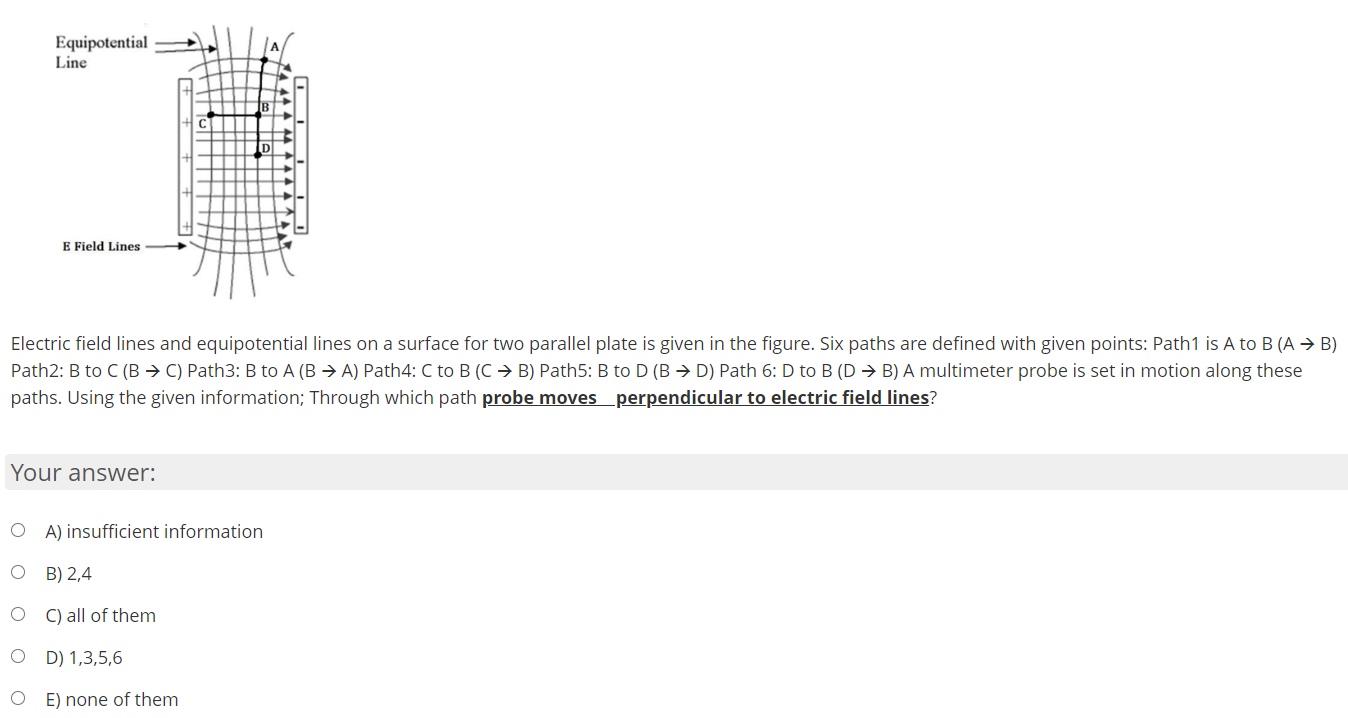Equipotential Line ID E Field Lines Electric field lines and equipotential lines on a surface for two parallel plate is given in the figure. Six paths are defined with given points: Path1 is A to B (A → B) Path2: B to C (B → C) Path3: B to A (B → A) Path4: C to B (C → B) Path5: B to D (B → D) Path 6: D to B (D → B) A multimeter probe is set in motion along these paths. Using the given information; Through which path probe moves perpendicular to electric field lines? Your answer: O A) insufficient information B) 2,4 C) all of them O D) 1,3,5,6 E) none of them
Equipotential Line ID E Field Lines Electric field lines and equipotential lines on a surface for two parallel plate is given in the figure. Six paths are defined with given points: Path1 is A to B (A → B) Path2: B to C (B → C) Path3: B to A (B → A) Path4: C to B (C → B) Path5: B to D (B → D) Path 6: D to B (D → B) A multimeter probe is set in motion along these paths. Using the given information; Through which path probe moves perpendicular to electric field lines? Your answer: O A) insufficient information B) 2,4 C) all of them O D) 1,3,5,6 E) none of them
Physics for Scientists and Engineers
10th Edition
ISBN:9781337553278
Author:Raymond A. Serway, John W. Jewett
Publisher:Raymond A. Serway, John W. Jewett
Chapter24: Electric Potential
Section: Chapter Questions
Problem 23P: Figure P24.23 shows several equipotential lines, each labeled by its potential in volts. The...
Related questions
Concept explainers
Dielectric Constant Of Water
Water constitutes about 70% of earth. Some important distinguishing properties of water are high molar concentration, small dissociation constant and high dielectric constant.
Electrostatic Potential and Capacitance
An electrostatic force is a force caused by stationary electric charges /fields. The electrostatic force is caused by the transfer of electrons in conducting materials. Coulomb’s law determines the amount of force between two stationary, charged particles. The electric force is the force which acts between two stationary charges. It is also called Coulomb force.
Question

Transcribed Image Text:Equipotential
Line
ID
E Field Lines
Electric field lines and equipotential lines on a surface for two parallel plate is given in the figure. Six paths are defined with given points: Path1 is A to B (A → B)
Path2: B to C (B → C) Path3: B to A (B → A) Path4: C to B (C → B) Path5: B to D (B → D) Path 6: D to B (D → B) A multimeter probe is set in motion along these
paths. Using the given information; Through which path probe moves
perpendicular to electric field lines?
Your answer:
O A) insufficient information
B) 2,4
C) all of them
O D) 1,3,5,6
E) none of them
Expert Solution
This question has been solved!
Explore an expertly crafted, step-by-step solution for a thorough understanding of key concepts.
This is a popular solution!
Trending now
This is a popular solution!
Step by step
Solved in 2 steps

Knowledge Booster
Learn more about
Need a deep-dive on the concept behind this application? Look no further. Learn more about this topic, physics and related others by exploring similar questions and additional content below.Recommended textbooks for you

Physics for Scientists and Engineers
Physics
ISBN:
9781337553278
Author:
Raymond A. Serway, John W. Jewett
Publisher:
Cengage Learning

Physics for Scientists and Engineers with Modern …
Physics
ISBN:
9781337553292
Author:
Raymond A. Serway, John W. Jewett
Publisher:
Cengage Learning

College Physics
Physics
ISBN:
9781938168000
Author:
Paul Peter Urone, Roger Hinrichs
Publisher:
OpenStax College

Physics for Scientists and Engineers
Physics
ISBN:
9781337553278
Author:
Raymond A. Serway, John W. Jewett
Publisher:
Cengage Learning

Physics for Scientists and Engineers with Modern …
Physics
ISBN:
9781337553292
Author:
Raymond A. Serway, John W. Jewett
Publisher:
Cengage Learning

College Physics
Physics
ISBN:
9781938168000
Author:
Paul Peter Urone, Roger Hinrichs
Publisher:
OpenStax College

Principles of Physics: A Calculus-Based Text
Physics
ISBN:
9781133104261
Author:
Raymond A. Serway, John W. Jewett
Publisher:
Cengage Learning

Classical Dynamics of Particles and Systems
Physics
ISBN:
9780534408961
Author:
Stephen T. Thornton, Jerry B. Marion
Publisher:
Cengage Learning
